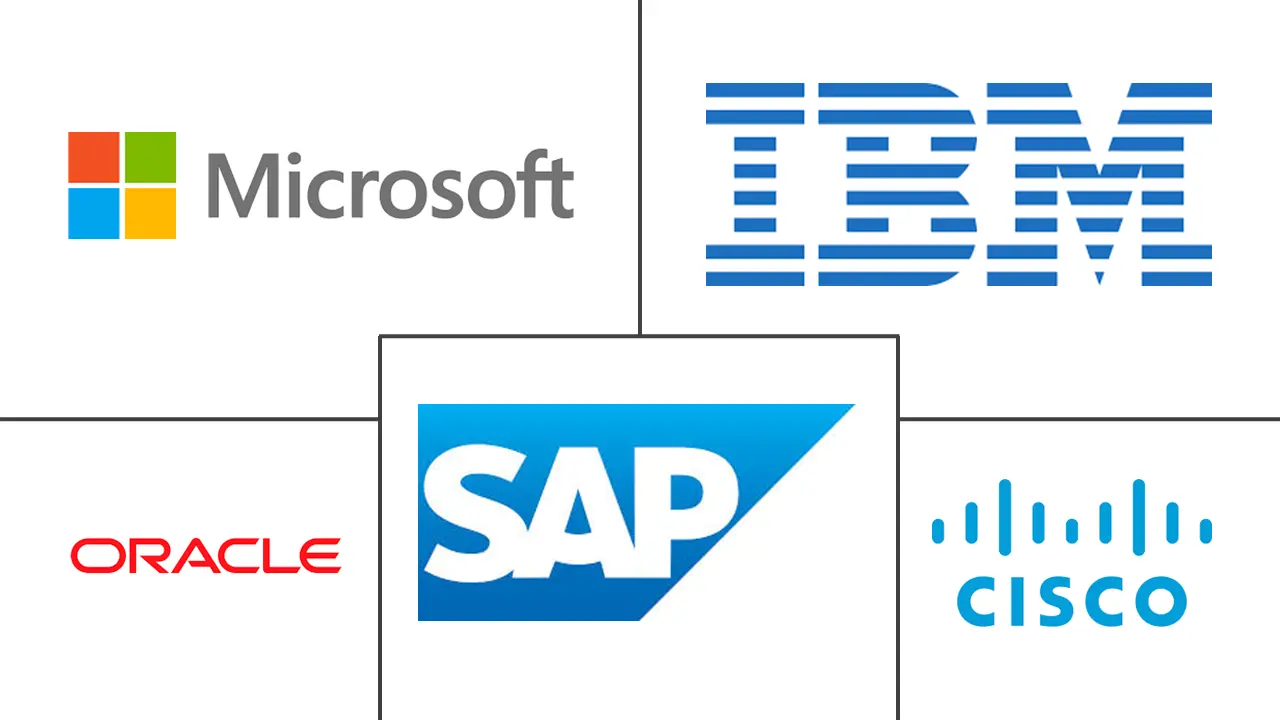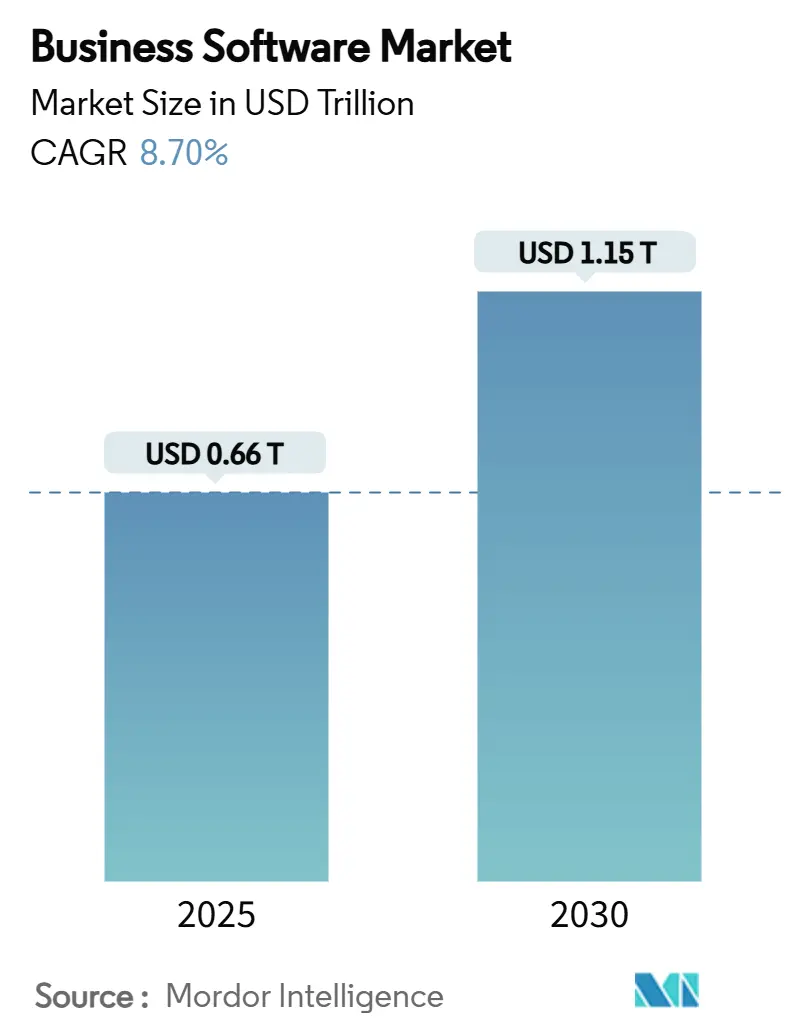
Business Software Market Analysis by Mordor Intelligence
The business software market stands at USD 0.66 trillion in 2025 and is forecast to reach USD 1.15 trillion by 2030, advancing at an 11.92% CAGR. This rapid expansion reflects enterprises’ pivot toward AI-enabled workflow automation, cloud-native deployment, and data-centric architectures that embed analytics directly into operational processes. Corporate demands for auditable ESG reporting, the need to rebuild resilient regional supply chains, and the mainstreaming of low-code development platforms each fuel fresh spending streams. Competitive pressure intensifies as incumbent platform vendors contend with AI-native challengers and open-source suites that offer lower total cost of ownership. Subscription pricing models deepen recurring revenue yet elevate customer acquisition costs, prompting vendors to refine value-based packaging and cloud cost-optimization services. Regional growth trajectories diverge: North American buyers focus on AI integration, Asia–Pacific organizations pursue cloud-first adoption, and European firms seek sovereignty-compliant offerings to meet GDPR and emerging data-localization mandates.
Key Report Takeaways
- By software type, Enterprise Resource Planning held 26.2% of 2024 business software market share, while Business Intelligence and Analytics is projected to expand at a 12.3% CAGR through 2030.
- By deployment model, the cloud segment commanded 59.8% share of the business software market size in 2024 and is forecast to grow 13.7% CAGR to 2030.
- By end-user industry, the BFSI sector led with 18.9% of 2024 revenue; Healthcare and Life Sciences is tracking a 12.1% CAGR to 2030.
- By organization size, large enterprises represented 65.2% of 2024 revenue, whereas the SME segment is projected to advance 13.3% CAGR through 2030.
- By geography, North America retained 25.3% revenue share in 2024; Asia–Pacific is the fastest-growing region at a 12.8% CAGR to 2030.
Global Business Software Market Trends and Insights
Drivers Impact Analysis
| Driver | (~) % Impact on CAGR Forecast | Geographic Relevance | Impact Timeline |
|---|---|---|---|
| AI-powered workflow automation adoption | +3.20% | Global, with North America and Asia-Pacific leading | Medium term (2-4 years) |
| Shift to subscription / SaaS revenue models | +2.80% | Global, particularly strong in North America and Europe | Short term (≤ 2 years) |
| Demand for unified data fabrics | +2.10% | North America and EU, expanding to Asia-Pacific | Medium term (2-4 years) |
| Low-code / no-code platforms in citizen development | +1.90% | Global, with SME-heavy regions showing higher adoption | Short term (≤ 2 years) |
| Rising ESG and sustainability reporting mandates | +1.50% | Europe leading, North America following, Asia-Pacific emerging | Long term (≥ 4 years) |
| Near-shoring and resilient digital supply chains | +1.30% | North America, Europe, select Asia-Pacific markets | Medium term (2-4 years) |
| Source: Mordor Intelligence | |||
AI-powered workflow automation adoption
Adoption of intelligent automation tools has moved far beyond rule-based bots as AI agents orchestrate tasks across ERP, CRM, and collaboration suites. Microsoft embedded Copilot agents across Office and Dynamics, enabling natural-language prompts that restructure end-to-end workflows.[1]Arun Ulag, “Introducing Microsoft Fabric,” microsoft.comCitizens Bank realized 20% productivity gains in software engineering after deploying AI code-generation assistants, while broader cross-industry studies cite functional productivity lifts of 30-55%. Vendors integrate contextual data from unified fabrics, so automation now drives decision quality rather than pure task speed. Early adopters secure defensible advantages as laggards struggle with legacy scripting tools lacking adaptive intelligence.
Shift to subscription / SaaS revenue models
More than half of U.S. enterprises will run core software via SaaS by 2025, unlocking over USD 100 billion in fresh B2B opportunity. The move aligns vendor income with customer value, yet raises stakes for churn management and usage-based contracting. Vietnamese research shows SME adoption outpacing large enterprises because pay-as-you-go pricing eases cash-flow constraints. Vendors embed AI in billing engines to personalize tiers and surface consumption insights, but enterprises simultaneously adopt FinOps practices to trim redundant seats. As cost visibility grows, provider differentiation hinges on measurable ROI, forcing sharper product road-mapping and post-sale success programs.
Demand for unified data fabrics
Enterprises are weaving data fabrics that connect lakes, warehouses, and operational stores without bulk migration. Microsoft Fabric unifies data governance layers and streams directly into Power BI and Azure Machine Learning. Government agencies adopt similar frameworks to unify siloed information while meeting sovereignty rules. Vendors such as IBM and Cloudera package policy-driven access controls that let teams train generative-AI models on live data sets. Unified fabrics shrink integration cycles, accelerate analytics deployment, and minimize compliance risk, making them a strategic backbone for digital operations.
Low-code / no-code platforms in citizen development
Seventy-seven percent of organizations now build applications with low-code tools, and analysts expect 65% of all app development to flow through these environments by 2026. Platforms such as Microsoft Power Apps and Mendix empower business users to build workflow apps without hand coding, trimming backlog queues and accelerating departmental innovation. AI copilots recommend data models, auto-generate interfaces, and enforce security patterns, broadening the talent pool beyond professional developers. Large enterprises prototype line-of-business apps in days, and SMEs deploy full management suites that replace fragmented spreadsheets. Challenges persist around version control, but centralized governance frameworks and marketplace component libraries mitigate most concerns.
Restraints Impact Analysis
| Restraint | (~) % Impact on CAGR Forecast | Geographic Relevance | Impact Timeline |
|---|---|---|---|
| Escalating cloud spend optimization pressure | -2.10% | Global, particularly North America and Europe | Short term (≤ 2 years) |
| Growing open-source alternatives | -1.80% | Global, with higher impact in cost-sensitive markets | Medium term (2-4 years) |
| Data-sovereignty and cross-border compliance hurdles | -1.40% | Europe leading, expanding globally | Long term (≥ 4 years) |
| Shortage of domain-specific implementation talent | -1.20% | Global, acute in specialized verticals | Medium term (2-4 years) |
| Source: Mordor Intelligence | |||
Escalating cloud spend optimization pressure
Economic uncertainty accelerates scrutiny of cloud invoices, prompting enterprises to deploy AI-powered cost-governance tools that right-size instances and automate de-allocation. Intel documented 34% savings for a global client after implementing continuous optimization frameworks.[2]Alexis Crowell, “Intel solution brief: Cloud cost optimization,” intel.com FinOps teams integrate these insights into procurement cycles, dampening vendor-license expansion and stretching renewal negotiations. Software providers must now quantify efficiency gains alongside functional benefits to retain wallet share.
Growing open-source alternatives
Mature open-source suites such as Odoo and ERPNext deliver ERP, CRM, and e-commerce functions at subscription prices that undercut proprietary platforms. Odoo’s marketplace hosts over 40,000 community modules, while ERPNext emphasizes code transparency and no lock-in.[3]Fabien Pinckaers, “Odoo Roadmap 2025,” odoo.com Adoption spikes among budget-constrained SMEs and public institutions seeking auditability. Vendors counter by offering managed open-core editions with enterprise support, yet competition restrains price escalation and erodes margins for mid-tier proprietary players.
Segment Analysis
By Software Type: ERP dominance faces analytics disruption
ERP solutions accounted for 26.2% of 2024 revenue, underscoring their role as the transactional backbone of the business software market. Large manufacturers, retailers, and public agencies rely on integrated finance, procurement, and production modules to maintain process discipline. Still, analytics platforms record a 12.3% CAGR through 2030 as companies prioritize data-driven decision cycles. Bakery chain St-Donat replaced legacy accounting tools with a food-specific cloud ERP that delivered lot traceability and mobile order capture on a USD 350,000 budget. In parallel, self-service BI suites democratize advanced visualization and predictive modeling, siphoning growth momentum from mature ERP lines.
The analytics wave coincides with executives’ push for predictive forecasting, automated data storytelling, and embedded AI recommendations. Vendors embed real-time dashboards into ERP workbenches, yet specialist providers scale faster by focusing on vertical KPIs such as clinical-trial performance or omnichannel marketing attribution. Finance, HR, and project-portfolio modules keep steady demand as compliance mandates expand audit scope, while ESG reporting tools emerge inside the “other” category. UL Solutions and Workiva each bundle carbon-accounting engines that capture emissions data across supply networks, reflecting the broader sustainability pivot.
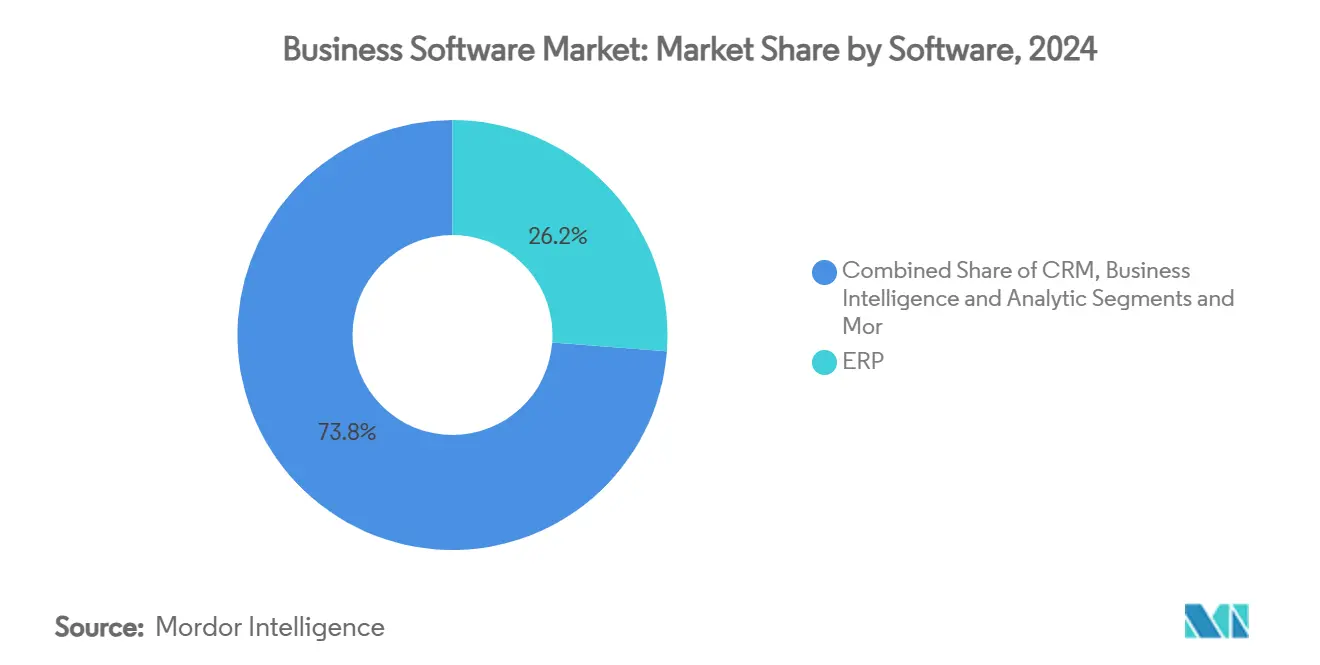
Note: Segment shares of all individual segments available upon report purchase
By Deployment: Cloud supremacy accelerates
Cloud deployments captured 59.8% of the business software market size in 2024 and are set to climb at a 13.7% CAGR. Ninety-five percent of enterprises have shifted at least one mission-critical workload to public or hybrid clouds, pursuing elastic scalability and faster feature cadence. Microsoft and Oracle extended their multi-cloud interconnect to new global regions, enabling customers to place databases near analytic engines without re-architecture. In APAC, 5G rollouts and state-backed datacenter programs compress migration timelines further.
On-premise installations persist in finance, defense, and healthcare where sovereignty or latency concerns prevail. Vendors now ship containerized versions of their stacks so clients can move workloads between private clusters and public clouds while preserving licensing and support entitlements. Sovereign-cloud services allow European banks to host regulated data inside national borders, blending compliance with cloud economics. Edge-computing blueprints emerge for logistics and manufacturing clients that require sub-millisecond response at plant sites yet central governance for analytics.
By End-User Industry: BFSI leadership faces healthcare disruption
The BFSI vertical held 18.9% revenue in 2024, reflecting investment in omnichannel banking, fraud analytics, and regulatory automation. Eighty-two percent of global banks increased AI budgets in 2025 as personalization and risk scoring became mandatory service differentiators. Yet healthcare and life sciences record a 12.1% CAGR, driven by electronic health records modernization, clinical-trial orchestration, and compliance with FDA data-integrity rules. A mid-stage biotech that transitioned from QuickBooks to NetSuite post-IPO illustrates the shift toward SOX-ready ERP configurations to support scale.
Government agencies accelerate digitization, adopting ServiceNow’s cloud workflow platform across more than 30 U.S. federal bodies. Manufacturing firms deploy supply-chain planning suites to hedge material-price volatility, while retailers focus on unified commerce engines that sync inventory across storefronts and e-commerce. Transportation, telecom, and renewable-energy players each integrate specialized modules for route optimization, subscriber management, and sustainability tracking.
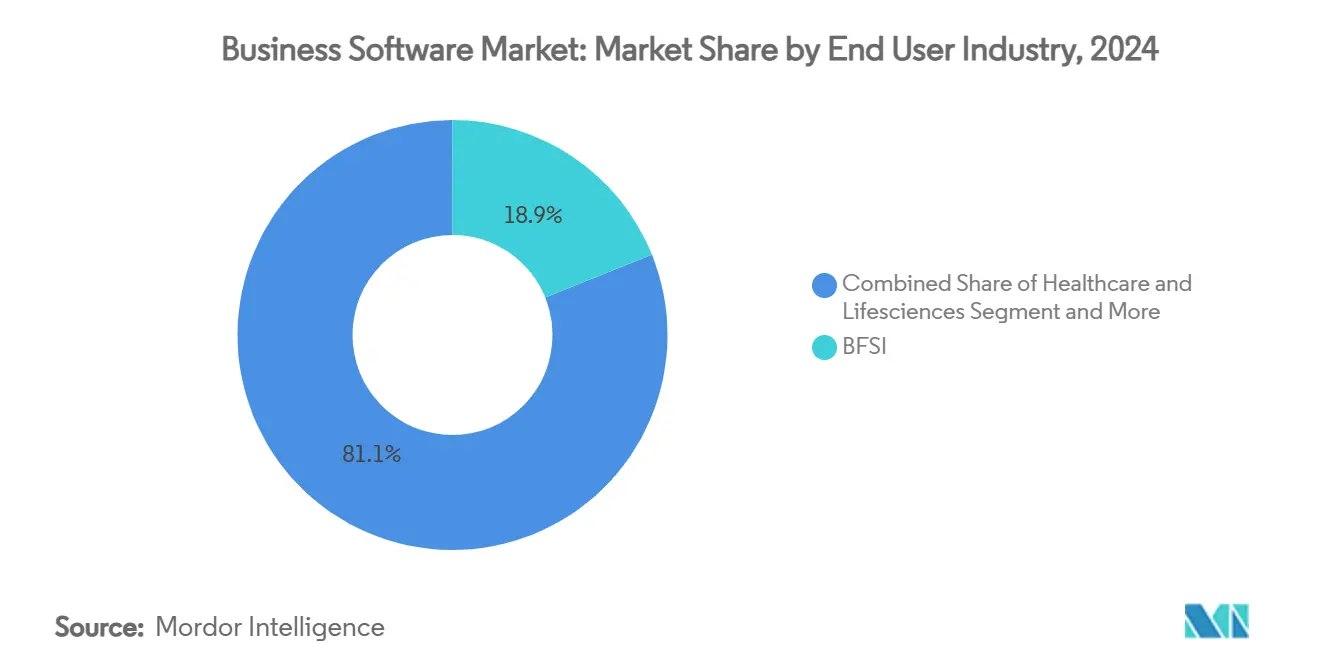
Note: Segment shares of all individual segments available upon report purchase
By Organization Size: SME growth outpaces enterprise adoption
Large enterprises generated 65.2% of 2024 revenue, yet SMEs are growing 13.3% CAGR to 2030, signaling the democratization of best-practice process management within the business software market. Pay-per-seat SaaS models remove capital expenditure barriers, and low-code platforms let non-technical founders design workflow apps that scale with headcount. Vietnamese studies confirm SME SaaS adoption surpasses that of bigger firms because subscription budgets map to monthly cash flow. Vendors package industry templates and guided-setup wizards that cut implementation from months to days.
SME demand catalyzes channel-led distribution strategies: ISVs recruit regional resellers, embed payment gateways, and bundle managed services. ManufacturingTomorrow reported that cloud ERP delivers mobile production dashboards and self-service KPIs to plant supervisors without dedicated IT staff. As SMB ecosystems expand in emerging markets, competition centers on simplified onboarding, local language support, and integrator community density.
Geography Analysis
North America retained 25.3% of 2024 revenue in the business software market, supported by mature cloud infrastructure and stringent sectoral regulations. Microsoft invested USD 16.75 billion in 2025 capital expenditures to keep pace with rising U.S. demand for AI training capacity. Canadian banks deploy sovereignty-compliant SaaS, while Mexican manufacturers digitize shop-floors to optimize near-shoring workflows. The region’s focus shifts from basic cloud migration to AI-infused productivity, expanding addressable spending beyond traditional license uplift.
Asia–Pacific is the fastest-growing geography, advancing at a 12.8% CAGR through 2030. China embeds enterprise software into government-led digital-economy initiatives, and local vendors harmonize with domestic cloud policies. Japan pursues workforce-productivity platforms to offset demographic pressures, whereas India’s booming SME segment harnesses low-code suites to formalize operations. Singapore and Hong Kong anchor regional cloud hubs, supplying latency-sensitive services to Southeast Asian e-commerce merchants.
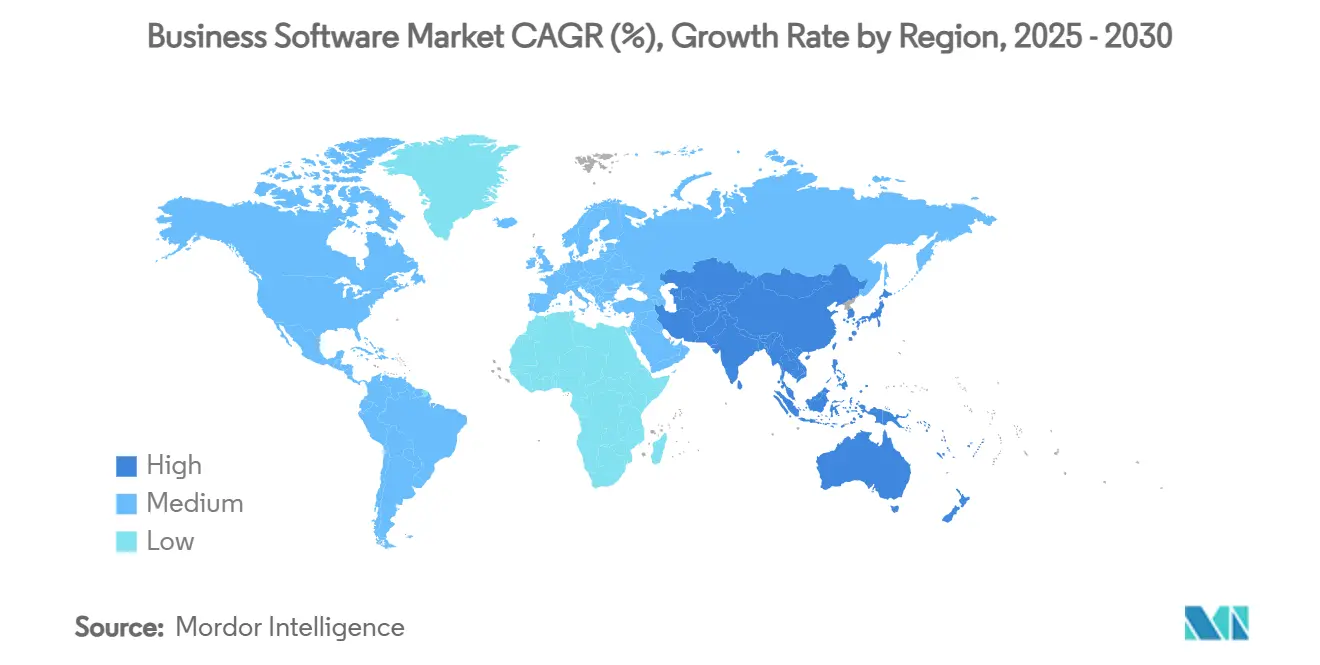
Competitive Landscape
The business software market is moderately consolidated yet highly competitive. Microsoft, Oracle, SAP, and Salesforce anchor the top tier with full-stack suites, global support networks, and co-innovation programs. Microsoft posted USD 70.1 billion in fiscal-2025 revenue, with Azure services rising 33% year on year, 16 points of which stemmed from AI workloads. Oracle tightened its alliance with Google Cloud to provide interconnectivity for shared customers, reinforcing multi-cloud positioning. SAP collaborates with Microsoft to accelerate RISE migrations via joint engineering roadmaps.
Below the leaders, Workday dominates human-capital and finance suites for large employers, ServiceNow controls IT-service management workflows, and Intuit expands its QuickBooks ecosystem into mid-market HR. AI-native entrants such as UiPath, Celonis, and Databricks scale rapidly by focusing on automation, process mining, and lakehouse analytics. Open-source vendors Odoo and ERPNext compete on price transparency and community extension libraries, gaining traction with cost-sensitive SMEs.
Business Software Industry Leaders
-
Microsoft Corporation
-
International Business Machines Corporation
-
Oracle Corporation
-
SAP SE
-
Cisco Systems Inc.
- *Disclaimer: Major Players sorted in no particular order
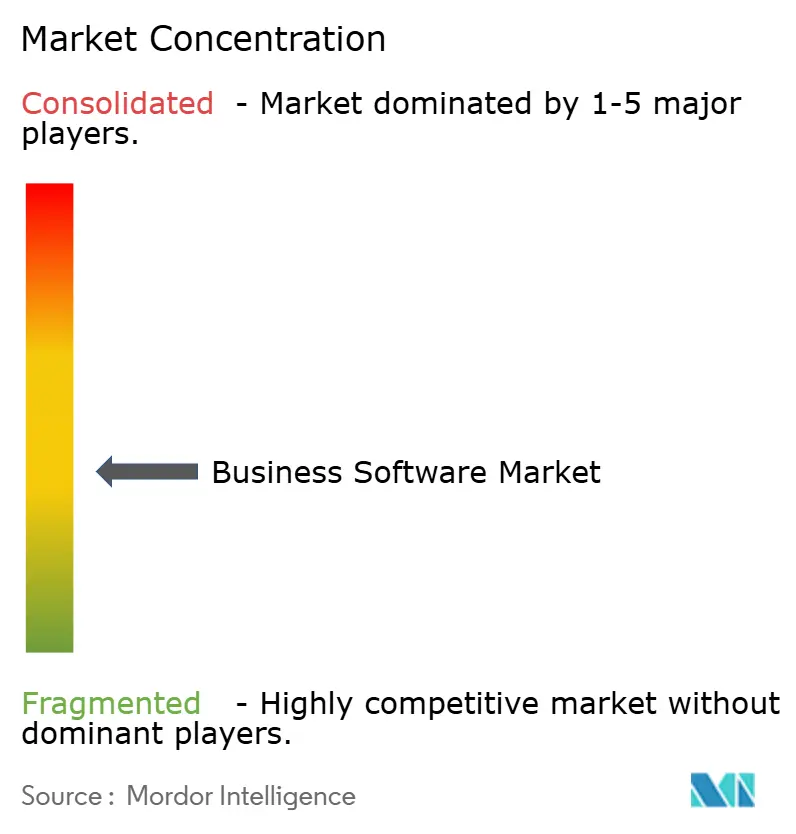
Recent Industry Developments
- May 2025: SAP launched the Business Suite Acceleration Program with Microsoft Cloud to streamline customer transitions to RISE with SAP.
- May 2025: Salesforce revealed plans to buy Informatica, aiming to unify AI and data-management services at scale.
- April 2025: Intuit announced the acquisition of GoCo to enhance AI-powered HCM functionality inside QuickBooks Payroll.
- April 2025: IBM completed its USD 6.4 billion acquisition of HashiCorp to build a comprehensive hybrid-cloud automation stack.
Global Business Software Market Report Scope
Business software is software that is used for business purposes. The term is often used more specifically for software that helps a business to accomplish specific goals through the applied principles that the software supports.
The global business software market is segmented by software type (ERP software, CRM software, BI software, and supply chain software), deployment (cloud and on-premise), end-user vertical (BFSI, healthcare, public & institutions, retail, transportation, manufacturing, and other end-user verticals (telecom, defense, etc.)), and geography (North America, Europe, Asia-Pacific, Latin America, and Middle East & Africa).
The market size and forecast are provided in terms of value (USD) for all the above segments.
| ERP |
| CRM |
| Business Intelligence and Analytics |
| Supply Chain Management |
| Human Resource Management |
| Finance and Accounting |
| Project and Portfolio Management |
| Others |
| Cloud |
| On-Premise |
| BFSI |
| Healthcare and Life Sciences |
| Government and Public Sector |
| Retail and E-commerce |
| Transportation and Logistics |
| Manufacturing |
| Telecommunications and Media |
| Others |
| Large Enterprises |
| Small and Medium Enterprises |
| North America | United States | |
| Canada | ||
| Mexico | ||
| South America | Brazil | |
| Argentina | ||
| Rest of South America | ||
| Europe | Germany | |
| United Kingdom | ||
| France | ||
| Italy | ||
| Spain | ||
| Rest of Europe | ||
| Asia-Pacific | China | |
| Japan | ||
| India | ||
| South Korea | ||
| Southeast Asia | ||
| Rest of Asia-Pacific | ||
| Middle East and Africa | Middle East | Saudi Arabia |
| United Arab Emirates | ||
| Turkey | ||
| Rest of Middle East | ||
| Africa | South Africa | |
| Nigeria | ||
| Egypt | ||
| Rest of Africa | ||
| By Software Type | ERP | ||
| CRM | |||
| Business Intelligence and Analytics | |||
| Supply Chain Management | |||
| Human Resource Management | |||
| Finance and Accounting | |||
| Project and Portfolio Management | |||
| Others | |||
| By Deployment | Cloud | ||
| On-Premise | |||
| By End-User Industry | BFSI | ||
| Healthcare and Life Sciences | |||
| Government and Public Sector | |||
| Retail and E-commerce | |||
| Transportation and Logistics | |||
| Manufacturing | |||
| Telecommunications and Media | |||
| Others | |||
| By Organization Size | Large Enterprises | ||
| Small and Medium Enterprises | |||
| By Geography | North America | United States | |
| Canada | |||
| Mexico | |||
| South America | Brazil | ||
| Argentina | |||
| Rest of South America | |||
| Europe | Germany | ||
| United Kingdom | |||
| France | |||
| Italy | |||
| Spain | |||
| Rest of Europe | |||
| Asia-Pacific | China | ||
| Japan | |||
| India | |||
| South Korea | |||
| Southeast Asia | |||
| Rest of Asia-Pacific | |||
| Middle East and Africa | Middle East | Saudi Arabia | |
| United Arab Emirates | |||
| Turkey | |||
| Rest of Middle East | |||
| Africa | South Africa | ||
| Nigeria | |||
| Egypt | |||
| Rest of Africa | |||
Key Questions Answered in the Report
What is the current size of the business software market?
The business software market is valued at USD 0.66 trillion in 2025.
How fast is the business software market expected to grow?
It is projected to expand at an 11.92% CAGR, reaching USD 1.15 trillion by 2030.
Which deployment model is growing the quickest?
Cloud deployment leads, holding 59.8% revenue in 2024 and advancing at a projected 13.7% CAGR through 2030.
Which industry vertical is forecast to grow the most rapidly?
Healthcare and Life Sciences shows the highest growth, tracking a 12.1% CAGR to 2030
Page last updated on:
